
Diving is the sport of jumping or falling into water from a platform or springboard, usually while performing acrobatics. Diving is an internationally recognized sport that is part of the Olympic Games. In addition, unstructured and non-competitive diving is a recreational pastime.

A potentiometer is a three-terminal resistor with a sliding or rotating contact that forms an adjustable voltage divider. If only two terminals are used, one end and the wiper, it acts as a variable resistor or rheostat.
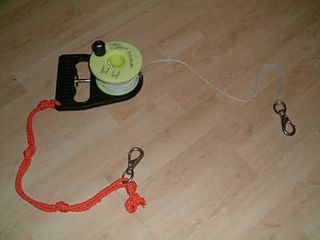
A distance line, penetration line, cave line, dive reel or guide line is an item of diving equipment used by scuba divers as a means of returning to a safe starting point in conditions of low visibility, water currents or where pilotage is difficult. They are often used in cave diving and wreck diving where the diver must return to open water after a penetration when it may be difficult to discern the return route. Guide lines are also useful in the event of silt out.

The Manchester Aquatics Centre, abbreviated MAC, is a public aquatics sports facility south of the city centre of Manchester, England, north of the main buildings of the University of Manchester near Manchester Metropolitan University. It was purpose built for the 2002 Commonwealth Games, and cost £32 million to build.

The London Aquatics Centre is an indoor facility with two 50-metre (164-foot) swimming pools and a 25-metre (82-foot) diving pool in Queen Elizabeth Olympic Park in Stratford, London. The centre, designed by architect Zaha Hadid as one of the main venues of the 2012 Summer Olympics and Paralympics, was used for the swimming, diving and synchronised swimming events. After significant modification, the centre opened to the public in March 2014.

Blue Knob State Park is a 6,128-acre (2,480 ha) Pennsylvania state park in Kimmel, Lincoln, and Pavia townships in Bedford County, Pennsylvania, in the United States. The average annual snowfall at the park is about 12 feet (370 cm). The park is named for Blue Knob, the second highest mountain in Pennsylvania at 3,146 feet (959 m). It is the location of Blue Knob All Seasons Resort, the ski slope in Pennsylvania with the highest elevation. Blue Knob State Park is just off Interstate 99 on Pennsylvania Route 869 west of Pavia.

The Sleeman Centre is a sporting and entertainment facility located in Brisbane, Queensland, Australia. Located on Old Cleveland Road in the suburb of Chandler, the Centre is 15 kilometres (9.3 mi) east of Brisbane's CBD and is home to an aquatic Centre, velodrome, sports arena, gymnastics training hall, gymnasium, and auditorium. The centre offers a range of services to the public.
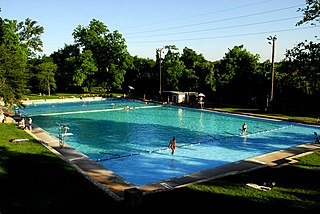
Deep Eddy Pool is a historic man-made swimming pool in Austin, Texas. Deep Eddy is the oldest swimming pool in Texas and features a bathhouse built during the Depression era by the Works Progress Administration. The pool began as a swimming hole in the Colorado River, became a resort in the 1920s, and is today a popular swimming pool operated by the City of Austin.
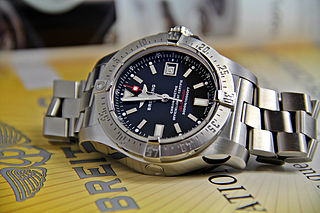
A diving watch, also commonly referred to as a diver's or dive watch, is a watch designed for underwater diving that features, as a minimum, a water resistance greater than 1.1 MPa (11 atm), the equivalent of 100 m (330 ft). The typical diver's watch will have a water resistance of around 200 to 300 m, though modern technology allows the creation of diving watches that can go much deeper. A true contemporary diver's watch is in accordance with the ISO 6425 standard, which defines test standards and features for watches suitable for diving with underwater breathing apparatus in depths of 100 m (330 ft) or more. Watches conforming to ISO 6425 are marked with the word DIVER'S to distinguish ISO 6425 conformant diving watches from watches that might not be suitable for actual scuba diving.

Moana Pool is the largest swimming pool in the southern half of New Zealand's South Island. It is located at the corner of Littlebourne Road and Upper Stuart Street close to Otago Boys' High School, on the slopes of Roslyn, overlooking the centre of the city of Dunedin. The pool complex can be seen from much of the city, and commands extensive views over central and coastal Dunedin.

Katherine Louise Rawls, also known by her married names Katherine Thompson and Katherine Green, was an American competition swimmer and diver. She was the United States national champion in multiple events during the 1930s.

The Pan Am Pool is an indoor swimming facility in Winnipeg, Manitoba, Canada built for the 1967 Pan American Games. It is located in southwest Winnipeg and consists of three pools: two are used for competitive swimming and one is a children's "kiddie pool".

The James E. Martin Aquatics Center is a swimming complex on the Auburn University campus in Auburn, Alabama. It is the home pool of the Auburn University and Auburn High School swimming and diving programs. The Martin Aquatics Center has hosted the NCAA Men's (1998) and Women's (2003) Swimming and Diving Championships, as well as the US Open in 1995, 2000, and 2005. In 2002, Sports Illustrated rated the Martin Aquatics Center indoor pool the third-fastest pool in the United States.
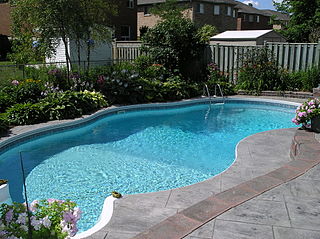
A swimming pool, swimming bath, wading pool, paddling pool, or simply pool, is a structure designed to hold water to enable swimming or other leisure activities. Pools can be built into the ground or built above ground, and may be found as a feature aboard ocean-liners and cruise ships. In-ground pools are most commonly constructed from materials such as concrete, natural stone, metal, plastic, composite or fiberglass, and can be of a custom size and shape or built to a standardized size, the largest of which is the Olympic-size swimming pool.
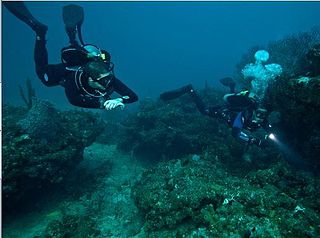
The trim of a diver is the orientation of the body in the water, determined by posture and the distribution of weight and volume along the body and equipment, as well as by any other forces acting on the diver. Both static trim and its stability affect the convenience and safety of the diver while under water and at the surface. Midwater trim is usually considered at approximately neutral buoyancy for a swimming scuba diver, and neutral buoyancy is necessary for efficient maneuvering at constant depth, but surface trim may be at significant positive buoyancy to keep the head above water.

The metresea water (msw) is a metric unit of pressure used in underwater diving. It is defined as one tenth of a bar.

Introductory diving, also known as introductory scuba experience, trial diving and resort diving are dives where people without diver training or certification can experience scuba diving under the guidance of a recreational diving instructor. Introductory diving is an opportunity for interested people to find out by practical experience at a relatively low cost if they would be interested in greater involvement in scuba diving. For scuba instructors and diving schools is it an opportunity to acquire new customers. An introductory diving experience is much less time-consuming and costly than the completion of autonomous diver training, but has little lasting value, as it is an experience program only, for which no certification is issued. Introductory scuba diving experiences are intended to introduce people to recreational diving, and increase the potential client base of dive shops to include people who do not have the time or inclination to complete an entry-level certification program.



















